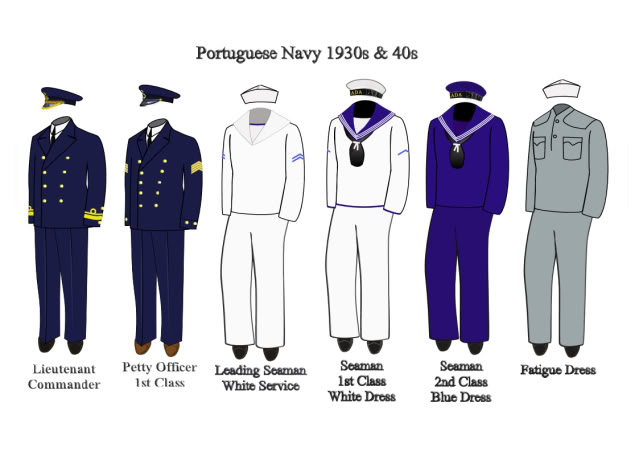Portugal 1920
2 posters
Page 1 of 1
 Portugal 1920
Portugal 1920

At the time of the overthrow of the Portugese monarchy in 1910, army uniforms were in a transitional period. The historic blue uniforms were still worn for parade but a grey field uniform was in the process of being introduced. Photographs of the fighting in Lisbon on 4 October show some units in grey, others in dark blue.
The new Republican government, along with more substantive reforms of the Army, introduced new "uniformes a francesa" (French style uniforms) for officers. These proved unpopular because of their expense to an officer corps that was (i) notably underpaid and (ii) still inclined to be Royalist in sentiment. Accordingly simplified modern styles for both dress and field uniforms was introduced in 1914. This is shown in the Spanish plate above. By 1920 only officers and senior NCOs were wearing the dark blue tunics and light blue trousers shown as a dress uniform, while all ranks wore the light grey field dress also shown. It was the latter (with the addition of a corrugated steel helmet) that was worn by the Portugese expeditionary force sent to the Western Front in 1917.
buistR- Posts : 345
Join date : 2008-05-21
 The Navy
The Navy
Here's a couple of uniforms for the navy from the 1930s and 1940s to go along with your army plate R.
Afraid I've no real information on the ranks. According to the US uniforms & insignia of the Navies the ranks follow the British ranks with a few minor changers but shows the following: Lt. Commander one thick below one medium, Commander, one thick below two medium & Captains braid was one thick band below three medium.
Yet post WWII the ranks do seem to follow the British system with the Captain's for example being four medium bands.
Rear Admiral with thick band only while senior Admirals have two and tree stars below the bands respectively.
Does this make sense?
WF

Afraid I've no real information on the ranks. According to the US uniforms & insignia of the Navies the ranks follow the British ranks with a few minor changers but shows the following: Lt. Commander one thick below one medium, Commander, one thick below two medium & Captains braid was one thick band below three medium.
Yet post WWII the ranks do seem to follow the British system with the Captain's for example being four medium bands.
Rear Admiral with thick band only while senior Admirals have two and tree stars below the bands respectively.
Does this make sense?
WF

Last edited by wfrad on Tue 19 Jul 2022, 3:12 am; edited 1 time in total (Reason for editing : removing photobucket)
wfrad- Posts : 16416
Join date : 2008-04-16
Location : Durham UK
 Navy Ranks 1950s
Navy Ranks 1950s
This chart is mainly taken from a NATO booklet ‘Know your Allies’ printed in France.
The Admiral stars seem to be silver in the booklet but I have also seen them illustrated in gold/yellow for the same period, I used gold/yellow purely on the basis that I prefer the gold/yellow.
I haven’t found the date when the stars were removed, but in the seventies Warrant Officer ranks changed and all non commissioned ranks changed again later on, Petty Officer chevrons changing to angled stripes like the Belgium navy while Warrant Officers gained braid on the sleeve behind their rank badges.
Anyway, I think you get the general idea.
Any mistakes please feel free to correct.

Regards
WF
The Admiral stars seem to be silver in the booklet but I have also seen them illustrated in gold/yellow for the same period, I used gold/yellow purely on the basis that I prefer the gold/yellow.
I haven’t found the date when the stars were removed, but in the seventies Warrant Officer ranks changed and all non commissioned ranks changed again later on, Petty Officer chevrons changing to angled stripes like the Belgium navy while Warrant Officers gained braid on the sleeve behind their rank badges.
Anyway, I think you get the general idea.
Any mistakes please feel free to correct.

Regards
WF
Last edited by wfrad on Tue 19 Jul 2022, 3:10 am; edited 1 time in total
wfrad- Posts : 16416
Join date : 2008-04-16
Location : Durham UK
 Re: Portugal 1920
Re: Portugal 1920
That's an impressive bit of rapid research and illustrating WF. The Portugese Navy is not a particularly well documented service in spite of its very long existance. If you get the chance visit the Portugese Maritime Museum in Lisbon - unlike its rather dusty Army equivalent it is very modern and has a tremendous range of displays ranging from actual multi-oared galleys to (yes) uniforms.
buistR- Posts : 345
Join date : 2008-05-21
 Lisbon
Lisbon
The problem with visiting Lisbon would be 'She Who Rules' would be in attendance and will probably have many more plans than military museums.
It's one of the places where you always intend to visit, like Barcelona, which I found to be a little disappointing.
So I'll inform 'She Who Rules' that it's dust free and exciting.
Regrds
WF
It's one of the places where you always intend to visit, like Barcelona, which I found to be a little disappointing.
So I'll inform 'She Who Rules' that it's dust free and exciting.
Regrds
WF
wfrad- Posts : 16416
Join date : 2008-04-16
Location : Durham UK
 Similar topics
Similar topics» Spanish Navy 1920-25
» French army tirailleurs indochinois/annamites
» Portuguese Colonial Infantryman
» Late 1910s, Haitian Gendarmerie
» The various Swiss Cantonal Police Forces
» French army tirailleurs indochinois/annamites
» Portuguese Colonial Infantryman
» Late 1910s, Haitian Gendarmerie
» The various Swiss Cantonal Police Forces
Page 1 of 1
Permissions in this forum:
You cannot reply to topics in this forum